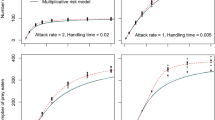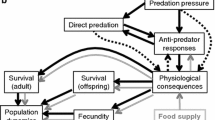Abstract
Investigating how prey density influences a prey’s combined predation risk from multiple predator species is critical for understanding the widespread importance of multiple predator effects. We conducted experiments that crossed six treatments consisting of zero, one, or two predator species (hellgrammites, greenside darters, and creek chubs) with three treatments in which we varied the density of mayfly prey. None of the multiple predator effects in our system were independent, and instead, the presence of multiple predator species resulted in risk reduction for the prey across both multiple predator combinations and all three levels of prey density. Risk reduction is likely to have population-level consequences for the prey, resulting in larger prey populations than would be predicted if the effects of multiple predator species were independent. For one of the two multiple predator combinations, the magnitude of risk reduction marginally increased with prey density. As a result, models predicting the combined risk from multiple predator species in this system will sometimes need to account for prey density as a factor influencing per-capita prey death rates.



Similar content being viewed by others
References
Abrams PA (1995) Implications of dynamically variable traits for identifying, classifying, and measuring direct and indirect effects in ecological communities. Am Nat 146:112–134
Bolker B, Holyoak M, Krivan V, Rowe L, Schmitz O (2003) Connecting theoretical and empirical studies of trait-mediated interactions. Ecology 84:1101–1114
Connell SD (2000) Is there safety-in-numbers for prey? Oikos 88:527–532
Dahl J, Greenberg L (1996) Impact on stream benthic prey by benthic vs drift feeding predators: a meta-analysis. Oikos 77:177–181
Dudgeon D (1996) Life histories, secondary production, and microdistribution of heptageniid mayflies (Ephemeroptera) in a tropical forest stream. J Zool 240:341–361
Eklov P (2000) Chemical cues from multiple predator-prey interactions induce changes in behavior and growth of anuran larvae. Oecologia 123:192–199
Eklov P, Van Kooten T (2001) Facilitation among piscivorous predators: effects of prey habitat use. Ecology 89:2486–2494
Elliott JM (2003) A comparative study of the functional response of four species of carnivorous stoneflies. Freshw Biol 48:191–202
Hirvonen H, Ranta E (1996) Prey to predator size ratio influences foraging efficiency of larval Aeshna juncea dragonflies. Oecologia 106:407–415
Huang C, Sih A (1990) Experimental studies on behaviorally mediated, indirect interactions through a shared predator. Ecology 71:1515–1522
Jacobi DI, Benke AC (1991) Life histories and abundance patterns of snag-dwelling mayflies in a blackwater Coastal Plain river. J N Am Benthol Soc 10:372–387
Kajita Y, Takano F, Yasuda H, Agarwala BK (2000) Effects of indigenous ladybird species (Coleoptera: Coccinellidae) on the survival of an exotic species in relation to prey abundance. Appl Entomol Zool 35:473–479
Kirk DJ, Smock LA (2000) Interspecific and intraspecific interactions between crayfish (Cambarus longulus) and hellgrammites (Corydalus cornutus) and the influence of a predatory fish (Micropterus dolomieu). Am Midl Nat 144:317–327
Kratz KW (1996) Effects of stoneflies on local prey populations: mechanisms of impact across prey density. Ecology 77:1573–1585
Krause J, Ruxton GD, Rubenstein D (1998) Is there always an influence of shoal size on predator hunting success? J Fish Biol 52:494–501
Losey JE, Denno RF (1998) Positive predator-predator interactions: enhanced predation rates and synergistic suppression of aphid populations. Ecology 79:2143–2152
Magnan P, FitzGerald GJ (1984) Ontogenetic changes in diel activity, food habits and spatial distribution of juvenile and adult creek chub, Semotilus atromaculatus. Environ Biol Fish 11:301–307
Martin TH, Wright RA, Crowder LB (1989) Non-additive impact of blue crabs and spot on their prey assemblages. Ecology 70:1935–1942
Obrycki JJ, Giles KL, Ormord AM (1998) Interactions between an introduced and indigenous coccinellid species at different prey densities. Oecologia 117:279–285
Peckarsky BL (1980) Predator-prey interactions between stoneflies and mayflies: behavioral observations. Ecology 61:932–943
Peckarsky BL (1991) Mechanisms of intra- and interspecific interference between larval stoneflies. Oecologia 85:521–529
Peckarsky BL, Cowan CA (1995) Microhabitat and activity periodicity of predatory stoneflies and their mayfly prey in a western Colorado stream. Oikos 74:513–521
Peckarsky BL, Dodson SI (1980) Do stonefly predators influence benthic distributions in streams? Ecology 61:1275–1282
Peckarsky BL, Penton MA (1985) Is predaceous stonefly behavior affected by competition? Ecology 66:1718–1728
Phillips EC (1996) Habitat preference of large predatory aquatic insects (Megaloptera and Odonata) in Ozark streams of Arkansas. Texas J Sci 48:255–260
Rahel FJ, Stein RA (1988) Complex predator-prey interactions and predator intimidation among crayfish, piscivorous fish, and small benthic fish. Oecologia 75:94–98
Roell MJ, Orth DJ (1991) Production of dobsonfly (Corydalus cornutus) larvae in the New River of West Virginia. J Freshw Ecol 6:1–9
Sih A, Englund G, Wooster D (1998) Emergent impacts of multiple predators on prey. Trends Ecol Evol 13:350–355
Smith PW (1979) The fishes of Illinois. University of Illinois Press, Champaign
Sokol-Hessner L, Schmitz OJ (2002) Aggregate effects of multiple predator species on a shared prey. Ecology 83:2367–2372
Soluk DA (1993) Multiple predator effects: predicting combined functional response of stream fish and invertebrate predators. Ecology 74:219–225
Soluk DA, Collins NC (1988a) Synergistic interactions between fish and stoneflies: facilitation and interference among stream predators. Oikos 52:94–100
Soluk DA, Collins NC (1988b) A mechanism for interference between stream predators: responses of the stonefly Agnetina capitata to the presence of sculpins. Oecologia 76:630–632
Spiller DA, Schoener TW (1994) Effects of top and intermediate predators in a terrestrial food web. Ecology 75:182–196
Stauffer HP, Semlitsch RD (1993) Effects of visual, chemical and tactile cues of fish on the behavioral responses of tadpoles. Anim Behav 46:355–364
Van Buskirk J (1988) Interactive effects of dragonfly predation in experimental pond communities. Ecology 69:857–867
Vance-Chalcraft HD (2003) The effects of multiple predator species on the prey’s risk of predation. Dissertation, University of Illinois
Vance-Chalcraft HD, Soluk DA, Ozburn N (2004) Is prey predation risk influenced more by increasing predator density or predator species richness in stream enclosures? Oecologia 139:117–122
Vonesh JR, Osenberg CW (2003) Multi-predator effects across life-history stages: non-additivity of egg- and larval-stage predation in an African treefrog. Ecol Lett 6:503–508
Welsh SA, Perry SA (1998) Habitat partitioning in a community of darters in the Elk River, West Virginia. Environ Biol Fish 51:411–419
Werner EE, Gilliam JF (1984) The ontogenetic niche and species interactions in size-structured populations. Annu Rev Ecol Syst 15:393–425
Wilbur HM, Fauth JE (1990) Experimental aquatic food webs: interactions between two predators and two prey. Am Nat 135:176–204
Wissinger S, McGrady J (1993) Intraguild predation and competition between larval dragonflies: direct and indirect effects on shared prey. Ecology 74:207–218
Wootton JT (1994) Predicting direct and indirect effects: an integrated approach using experiments and path analysis. Ecology 75:151–165
Yasuda H, Ishikawa H (1999) Effects of prey density and spatial distribution on prey consumption of the adult predatory ladybird beetle. J Appl Entomol 123:585–589
Acknowledgements
We would like to thank Jason Cashmore, David Chalcraft, Jon Hoekstra, Nicholas Ozburn, Stacy Salavitch, and Molly Tranel for help in the field and/or lab. We would also like to acknowledge the suggestions of David Chalcraft, Steven Kohler, Ken Paige, Gene Robinson, Ken Schmidt, Jeff Steinmetz and the rest of the Soluk lab group. Funding for this project came from the University of Illinois Graduate College and a NSF dissertation improvement grant (DEB-0104644). Any opinions, findings, and conclusions or recommendations expressed in this publication are those of the authors and do not necessarily reflect the views of the National Science Foundation. Logistical support during the writing of this manuscript was provided by Michael Willig, the Department of Biological Sciences at Texas Tech University, and the Department of Biology at East Carolina University.
Author information
Authors and Affiliations
Corresponding author
Additional information
Communicated by Steve Kohler
Rights and permissions
About this article
Cite this article
Vance-Chalcraft, H.D., Soluk, D.A. Multiple predator effects result in risk reduction for prey across multiple prey densities. Oecologia 144, 472–480 (2005). https://doi.org/10.1007/s00442-005-0077-5
Received:
Accepted:
Published:
Issue Date:
DOI: https://doi.org/10.1007/s00442-005-0077-5




